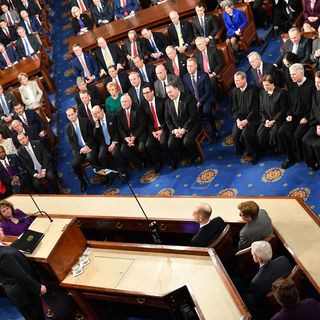The 'State of the Union' refers to the constitutionally-mandated duty of the US president to keep the House of Representatives and Senate abreast of the current conditions of the United States and the president's upcoming legislative agenda.
Article II, Section 3, Clause 1 of the US Constitution states that the president “shall from time to time give to the Congress Information of the State of the Union, and recommend to their consideration such measures as he shall judge necessary and expedient”.
Interpretations of how this should be met have changed over the life of the republic, but one consensus has been that it should be a yearly update. Although presidents often address a joint session of Congress in their first inauguration year, it's considered too soon for a State of the Union address to be delivered. The first such fulfilment of the constitutional duty generally occurs in January of their second year.
The transformation of the State of the Union
Initially, the presidential fulfilment was known as the ‘Annual Message’. Both presidents George Washington and John Adams delivered the first 12 annual messages directly to a joint sitting of the Congress, but Adams' successor Thomas Jefferson saw it as extraneously timely and too kingly to dictate a speech to the Congress rather than giving congressmen requisite time to digest and officially respond to a written message. This remained the norm until President Woodrow Wilson revived the practice of delivering the message to the Congress in person in 1913. Since 1947 the address has been officially termed ‘the State of the Union’.

The tradition has since often strayed from the ceremony of today, but with the advancement of broadcast technology, it has steadily transformed into a message directed at the nation as well as the Congress. The first radio broadcast of an address was Calvin Coolidge’s in 1923 and the first televised address was Harry Truman’s in 1947. Truman (1946, '53), Eisenhower (1961) and finally Carter (1981)[^1] were the last to revert to written-only messages; Franklin D. Roosevelt (1945) and Eisenhower (1956) both wrote to Congress and addressed the nation separately on the radio. In 1965 Lyndon B. Johnson scheduled the address in the evening to reach a wider television audience, which became standard practice (Franklin Roosevelt had trialled this in 1936 for radio listeners). Nixon (1972, '73, '74) and Carter (1978, '79, '80) delivered both an oral and written message. In 2002, George W. Bush’s address was the first to be webcast.
State of the Union ratings
For a ratings-driven President Trump, the State of the Union offers a uniquely large platform to showcase his leadership. It is the only annual occasion that offers the president the chance to combine several important constitutional roles: chief of state, chief executive, chief diplomat, commander-in-chief and chief legislator. Along with the Super Bowl, Grammys and Oscars, the State of the Union is one of the highest-rating billings on the television calendar, particularly in the early years of a presidency.
President Trump’s first State of the Union drew 45.6 million viewers domestically, which the president falsely claimed were the highest ratings in history. Presidents Clinton, W. Bush and Obama all eclipsed this figure during their presidential terms. His second in 2019 rated higher than Clinton's first term efforts with an average of 46.8 million viewers over the address.
What to expect from the 2020 State of the Union
The State of the Union address is typically one of the more optimistic and bipartisan speeches a president gives. As its purpose is ostensibly to provide an update on the progress of the presidency, it makes sense for it to take this dignified tone. But this year's State of the Union has an additional element that only one other State of the Union has carried: it will be delivered during an active impeachment trial in the Senate.
The State of the Union offers Donald Trump a life raft. Will he take it?

The last time this occurred was in 1999 during President Bill Clinton's impeachment trial.
Clinton's address highlighted his achievements and avoided any direct mention of the trial that had been taking place just hours beforehand. This was emblematic of the Clinton team's broader approach to impeachment proceeding: have the president appear above them and too preoccupied with his job to even engage.
President Trump will hype his achievements as well.
In recent weeks President Trump has been astutely collecting "wins" to brandish during the State of the Union as well as an election campaign: a Middle East peace plan, a phase one trade deal with China, a US-Mexico-Canada trade deal, chest-thumping at Iran and the assassination of its highest-ranking general, a Supreme Court ruling in his administration's favour on tough immigration reforms and the steady trickle of news about the strength of the economy, despite some lower than expected indicators.
These are all likely to feature extensively in his address and he will claim personal responsibility for all of them.
But any suggestion the President is has been too busy to tune in to impeachment cannot be taken seriously.
President Trump's Twitter feed has been filled with play-by-play commentary, ridicule, fury, threats and disparagement.
In fact, on the opening day of the Senate trial and despite being an ocean away from Washington in Davos, Trump amassed 142 tweets and retweets in a day, a record for his time in office.
Team Trump has been keen to emphasise the president's achievements during official engagements and amplify these and other distractions from the proceedings. But the president uses his private time to vehemently fight back against his critics. It's hard not to see this filtering into his address.
In 2020, with the House still controlled by Democrats, impeachment revelations in hyperdrive and an election campaign already in full swing, President Trump will not miss the opportunity to hit hard on his message of endless winning in the face of the "most unfair WITCH HUNT" in American history.
Everything is re-election in Trump's eyes and there are enemies everywhere.
The Iowa Caucuses the night before will inform the angle of the Trump team's political language. Expect a broadside aimed at socialism if Sanders or Warren steal the night, or an emphasis on fighting corruption if Joe Biden pulls through.
Or expect them both, whatever the case.
Everything is re-election in Trump's eyes and there are enemies everywhere.
The State of the Union may still pay homage to the need for unity, but it will be another skirmish in his endless fight for his office.
Who will give the Democratic response to the State of the Union in 2020?
In 1966 Republicans began the unofficial practice of issuing a formal response to the State of the Union address. Both Democrats and Republicans have overwhelmingly maintained this tradition by having members of Congress from the opposition party deliver a televised rebuttal shortly after the president’s address. These generally garner considerably less interest than the president’s address but are seen as a testing ground for prospective candidates. Presidents Bill Clinton, Gerald Ford and George W. Bush, Speakers Pelosi and Ryan and 2016 candidates Marco Rubio and Tim Kaine have all given such responses.
In 2020, first-term Michigan Gov. Gretchen Whitmer will deliver the Democrats' official English language response to President Trump's State of the Union.
In 2020, first-term Michigan Gov. Gretchen Whitmer will deliver the Democrats' official English language response to President Trump's State of the Union. Trump won Michigan by a slim margin in 2016 and it is one of the crucial Rust Belt states the Democrats will have to flip in 2020 to win an Electoral College majority.
Gov. Whitmer won her office in 2018 by 10 points and is seen as a rising star in the Democratic Party who exemplifies what it takes for Democrats to win in red states.
Texas Congresswoman Veronica Escobar will deliver the Spanish-language response. Escobar represents El Paso, Texas and has been a vocal critic of President Trump, particularly his administration's position on gun control following the 2019 shooting in her district.
Who will be the designated survivor in 2020?
As all members of the legislative, executive and judicial arms of governments are expected to be present at State of the Union addresses, there are security measures in place to ensure that in the case of a calamity, the presidential line of succession is preserved. As such, a ‘designated survivor’ is nominated to cover for the unlikely event that all those attending the State of the Union died.
This survivor is usually a member of the cabinet and is given a full presidential secret service detail and taken to a secure location offsite for the duration of the proceedings. Reportedly accompanying the designated survivor for the evening is a military aide who carries the nuclear football.
For security reasons, the identity of the designated survivor only becomes apparent very shortly before the address is set to begin. In 2018 not even Agriculture Secretary Sonny Perdue’s staff knew that he was nominated until the afternoon of the State of the Union and they continued to plan for his attendance and related media events.
Additionally, since 2005 both parties have absented members to potentially act as a ‘rump legislature’ in the case of a calamity.




.jpg?rect=0,80,3000,1989&fp-x=0.5&fp-y=0.44772296905517583&w=320&h=212&fit=crop&crop=focalpoint&auto=format)

